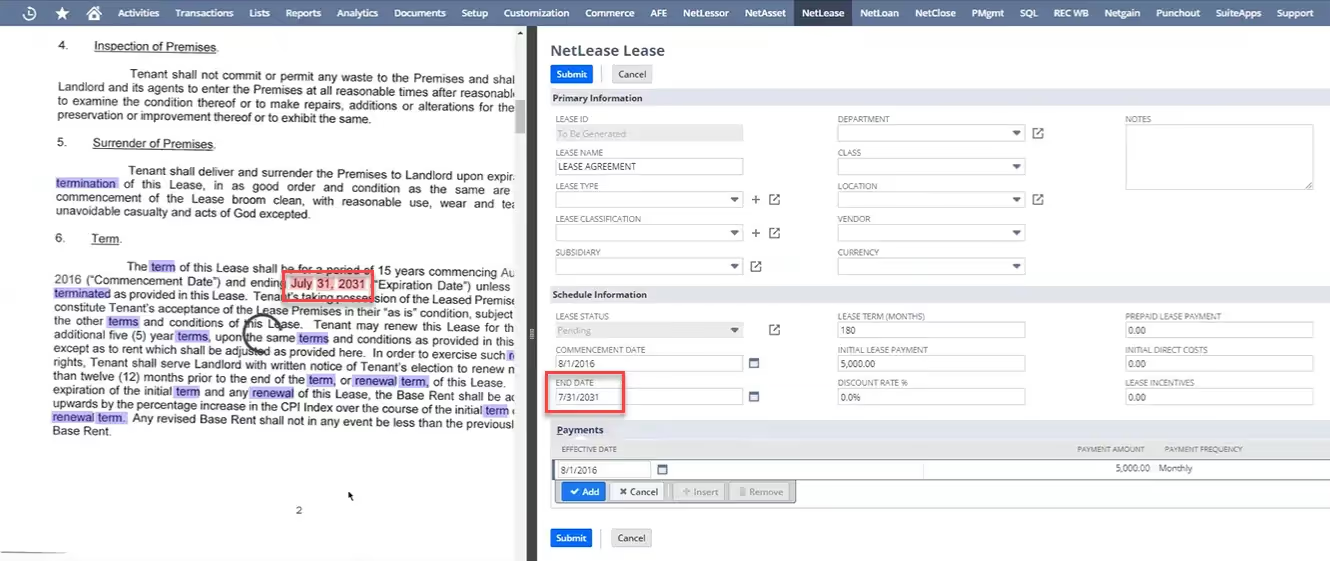If you work with lease contracts, you know how long and packed with information these documents can be. And while it may be tempting to skim them, they contain critical information that accountants need to ensure compliance with leasing standards.
ASC 842 has specific requirements for how leases should be recorded on the balance sheet depending on the lease term. This means that accountants must abstract key information from lease contracts to account for these nuances.
But collecting this information doesn’t have to be a lengthy process. You can rely on software and AI to quickly abstract lease information and ensure you meet the requirements of ASC 842.
This post will explain the importance of lease abstraction and how AI can help.
What is lease abstraction?
Least abstraction is the process of extracting, processing, and organizing key information from a lease contract. The result of this process is a lease abstract, a summarized document that gives you critical lease data at a glance so you can properly adopt standards like ASC 842 and IFRS 16 without spending hours poring over contracts.
Key components of a lease abstract
A lease abstract should include the following information:
- Lease title
- Lease type
- Lease classification (finance or operating lease under ASC 842 or IFRS 16 guidelines)
- Currency
- Lease commencement and end dates
- Lease term
- Initial lease payment
- Discount rate
- Base rent and payment schedule
- Rent escalations and adjustments
- Renewal and termination options
- Total lease obligations
- Security deposits
Why is lease abstraction important for ASC 842 compliance?
ASC 842 requires that all leases longer than 12 months be recorded as both a right-of-use (ROU) asset and lease liability on the balance sheet, among other requirements.
This means that accountants need key lease data on hand to correctly record leases on their balance sheet and ensure compliance. But this is a challenge for companies that don’t manage their leases in a centralized location and don’t have tools that help streamline the process.
Without a lease abstract, gathering relevant lease data can turn into a lengthy process that requires poring over long contracts and referencing past communications. A lease abstract speeds up the process, proving all the key information at a glance.
Let’s take a closer look at the benefits.
Benefits of lease abstraction
A streamlined lease abstraction process can help accounting teams manage leases more efficiently. The benefits include:
- Time savings: No more flicking through PDFs or combing through emails to track down the right information.
- Reduced regulatory risk: Lease abstraction with ASC 842 in mind will ensure that you are setting up your schedules correctly the first time and giving you easy access to all the information auditors need.
- Better decision-making: Once the data is abstracted, it is easily accessible for everyone. This empowers your team to make data-driven decisions. You may find yourselves analyzing the data in new ways that make your company more successful.
However, achieving these benefits can be easier said than done. Lease abstraction can be time-consuming when you do it manually or rely on rigid tools. But the right software can help.
How lease abstraction software and AI simplify the process
Lease management can be a full-time job (but for most accountants, it’s not their only job). Keeping track of all the details of a large portfolio needs careful attention so nothing falls through the cracks.
Many companies deal with this process manually, using spreadsheets, emails, and documents to track this critical information. But this is an inefficient use of time and can result in human error and decentralized data.
The first step toward a more efficient process is adopting lease accounting software that works seamlessly with your enterprise resource planning (ERP) platform, centralizes your data, and ensures compliance with lease accounting standards.
A solution that leverages automation and AI features will reduce your manual tasks and the risk of data entry errors.
AI-powered lease abstraction
While AI can’t replace the analytical work accountants do, it can take care of tedious tasks to help you work faster and focus on more strategic analysis. Lease abstraction is one of the tasks AI can take off your hands.
For example, NetLease has an AI upload feature that allows users to upload a lease contract and populates the information in the right fields, speeding up lease creation. All you have to do is review the information, add in any missing details, and submit.
Within minutes, you can have the new lease created in your system, including critical data like the lease term and lease classification. This helps ensure you’re accounting for leases correctly and complying with standards like ASC 842.

Simplify lease abstraction with NetLease
Lease abstraction is a powerful tool that helps companies successfully comply with ASC 842. But it doesn’t have to be a complex process that burns out your accounting team.
By using NetLease’s AI upload feature, you can automate extracting information from lease contracts and speed up lease creation. This can boost efficiency in your lease management while centralizing critical information to ensure compliance.
This is just one of NetLease’s automation features, along with automatically generated amortization schedules, easy lease modifications, and real-time reports. These features enable accounting teams to manage a high volume of leases without having to keep track of hundreds of spreadsheets.
Want to see it in action? Take a tour of NetLease, or request a personalized demo to discover how it can fit your needs.





.avif)